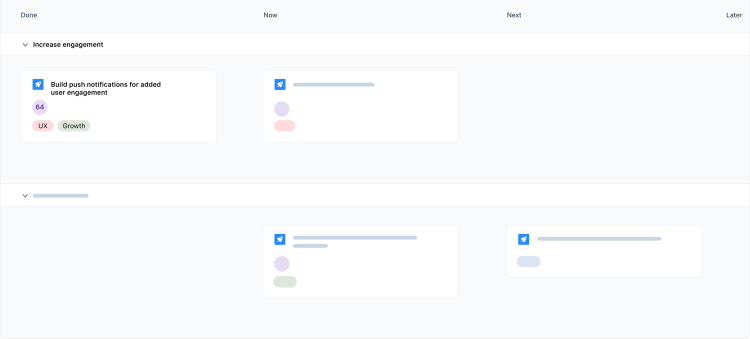
Outcome-based roadmap template
Discover it live
Preview

About this outcome-based roadmap template
Communicate, collaborate, and align with your stakeholders on the what and the why with this now-next-later roadmap. What you get:
An outcome-based roadmap board.
A backlog with a customizable prioritization framework.
More views: Priority chart, product timeline.
What is an outcome-based roadmap?
The outcome-based roadmap helps outline the potential scenarios for the product. Product teams can use an outcome-based roadmap to better communicate, collaborate and align with stakeholders on the what and the why of product development. With our outcome-based roadmap template, you can get started reaping those benefits in no time at all!
How do you create an outcome-based roadmap?
An outcome-based roadmap differs from other roadmaps a product team might use, in that it’s focused on the overall goals and objectives of the product development, rather than features or sprints. These goals will also often be critical to the success of the business.
Tony Ulwick of Strategyn has been quoted saying: “Without knowing precisely what target you are trying to hit, your chances of actually hitting it are slim.” And that’s exactly what an outcome-based product roadmap helps to avoid.
How do you create an outcome-based roadmap for yourself?
Step 1: Meet with the team, and key stakeholders to (re)agree on your product vision, strategy, and objectives.
Step 2: Distill these high-level goals into actionable ‘wins’ for the product development team.
Step 3: Build and design your outcome-based roadmap (we’ve got a template for that!) and put priorities in place.
Step 4: Share your outcome-based roadmap with the team and have it tattooed on their arm (we’re joking, of course, but the team should consider this roadmap as the holy grail for project planning).
Why use an outcome-based roadmap
Now that you understand what an outcome-based roadmap is, the big question is, “Why use one?”
At a very high level, an outcome-based roadmap will prioritize specific outcomes a product should achieve rather than the traditional approach of listing features which should be developed. At its core, the outcome-based roadmap is about strategy rather than tactics. This helps product teams adjust their focus from the fine-grain day-to-day feature building and instead zoom out a bit to look at the product through a wider lens.
So, what’s in it for a product team looking to deliver the best possible product? The benefits of using an outcome-based roadmap include:
Providing context for items on the roadmap and prioritizing features based on outcomes rather than tactical elements.
Ensuring product strategy is properly communicated while aligning key teams with that strategy. Focusing on strategy rather than features means an outcome-based roadmap will make sense for all stakeholders rather than just development teams.
Giving product teams more autonomy to make informed decisions aligned with the product's long-term goal.
Shifting the team's focus from the minutiae of specific features and updates to more holistic, strategic outcomes.
Example of an outcome-based roadmap
The best way to understand exactly how outcome-based roadmaps work is to look at an outcome-based roadmap example.
Let’s consider a fictional stock control and order processing SaaS product called “StockPal,” and let’s imagine that our long-term strategy includes two key long-term objectives. In this case, here’s what an example of an outcome-based roadmap might look like:
Product name: StockPal
Strategic goal #1: Improve the efficiency of order processing
Key outcomes:
Reduce order processing time by 50%
Increase order accuracy to 99%
Improve customer satisfaction rating by 10%
Strategic goal #2: Enhance the capability of stock control
Key outcomes:
Reduce out-of-stock incidents by 50%
Reduce over-stocking by 25%
Improve inventory accuracy to 95%
As you can see, this roadmap focuses on highly specific outcomes, like a reduction in key metrics, which will result in the efficiency of order processing and stock control capabilities of StockPal.
If this were a traditional feature-focused product roadmap, each element of the roadmap would be far more tactical. For example, rather than “Reduce order processing time by 50%,” this item might be “Upgrade the server back-end for order processing” or another specific technical improvement.
What to look for in an outcome-based roadmap template
If there’s one thing we can rely on in business, it’s change. Teams often find that their overall goals shift over time as other priorities emerge.
That’s why it’s important to use an outcome-based roadmap template that’s easy to adapt.�
The airfocus outcome-based roadmap template includes an outcome-based roadmap board, a backlog with a customizable prioritization framework, a 4x4 priority chart to visualize your quick wins and don’t dos, and a timeline to visualize your release plans. It only takes a few minutes to set up and evolve, as you need.
Try it for yourself today!
Get started with the outcome-based roadmap template now

Pre-installed apps
Priority Ratings
Set up a custom prioritization framework
Benefits that come from using this template
Powerful prioritization framework
Build a strategic product roadmap
Seamless integrations
Ready to use & fully customizable
Learn how to use airfocus templates effectively
More templates
Experience the new way of doing product management


Experience the new way of doing product management




